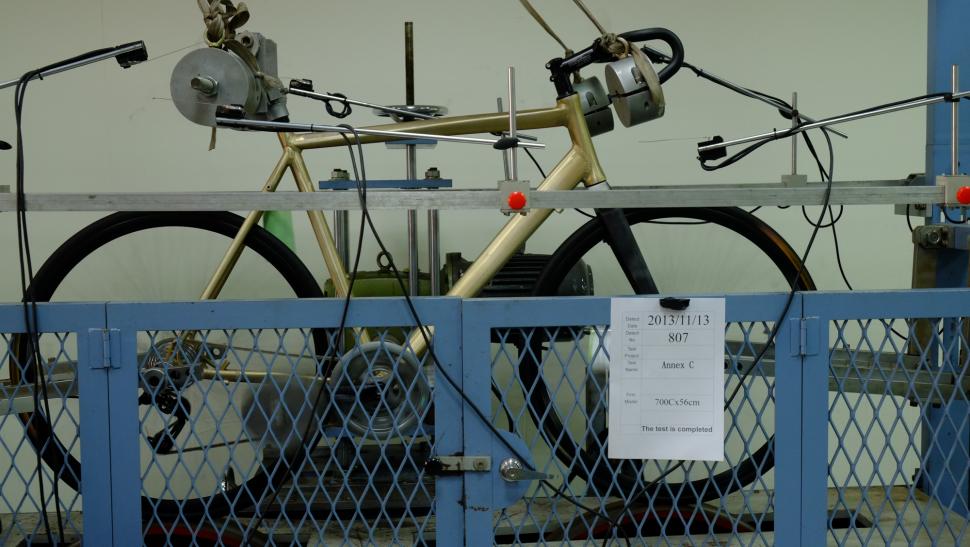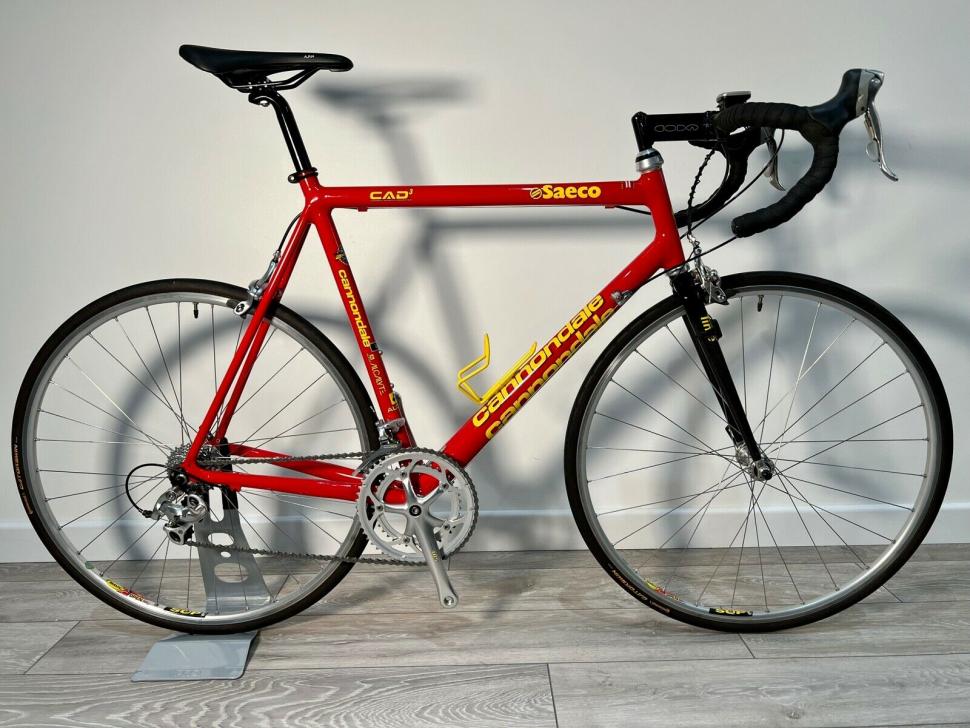- News
- Reviews
- Bikes
- Accessories
- Accessories - misc
- Computer mounts
- Bags
- Bar ends
- Bike bags & cases
- Bottle cages
- Bottles
- Cameras
- Car racks
- Child seats
- Computers
- Glasses
- GPS units
- Helmets
- Lights - front
- Lights - rear
- Lights - sets
- Locks
- Mirrors
- Mudguards
- Racks
- Pumps & CO2 inflators
- Puncture kits
- Reflectives
- Smart watches
- Stands and racks
- Trailers
- Clothing
- Components
- Bar tape & grips
- Bottom brackets
- Brake & gear cables
- Brake & STI levers
- Brake pads & spares
- Brakes
- Cassettes & freewheels
- Chains
- Chainsets & chainrings
- Derailleurs - front
- Derailleurs - rear
- Forks
- Gear levers & shifters
- Groupsets
- Handlebars & extensions
- Headsets
- Hubs
- Inner tubes
- Pedals
- Quick releases & skewers
- Saddles
- Seatposts
- Stems
- Wheels
- Tyres
- Health, fitness and nutrition
- Tools and workshop
- Miscellaneous
- Tubeless valves
- Buyers Guides
- Features
- Forum
- Recommends
- Podcast
OPINION
Aluminium frames are the work of the devil
 Aluminium bike stress testing - credit Steve Thomas
Aluminium bike stress testing - credit Steve ThomasMine may well have become vaguely lost in the great mist of time, but those distant memories, the harsh realisations and promises that I made to myself many years ago have come trickling back to haunt me in recent months... namely where I said I would never ride another aluminium bike frame.
> 10 of the best British bike brands of the '70s and '80s
First things first: before all the love for this great Coke can-like material comes flooding in down in the comments section, please do note that this is an opinion piece. It's based off my own many decades of experience riding bikes made from everything from bamboo to magnesium, with a whole heap of steel, titanium and aluminium thrown into the mix... oh and of course, some metal matrix too. These are my own groans aches and opinions, and I don't expect everyone to agree!
The pre-AL era
When I started riding and racing bikes in the '70s it was about steel, all about steel. From the forks right through it was all that good old hard stuff. There weren't really any other viable frame material options back then.
Sure enough the different tubing grades and builds did make for very different rides between the various combinations available, and mostly they were of the slightly forgiving kind. Thankfully in recent times there is some form of appreciation for steel coming back, and maybe even those younger riders who’ve never slung a leg over a quality steel horse will one day try one and find out why us old fellas love them so much (or at least some of us still do), even if they have drifted out of vogue.
> Southern Steel: take a trip down memory lane with these classic 20th century bike builders
Material world order
Perhaps I was lucky that I went from riding steel straight to various forms of titanium frames, and then to carbon fibre – lucky as in there were only a few fleeting encounters with the bone shacking and wrist jarring frights without the delights of aluminium bikes. Even then those that I did ride were mostly fat-tubed mountain bikes, where much of that harshness was padded out with big tyres, suspension, cross-laced wheels and slack angles.
I did have a couple of reasonable aluminium road frames back around the turn of the century, but even then I found them to be super harsh on the lower back and my wrists, which were rattled to popping point after years of pre-suspension mountain biking.
Back then, aluminium had become the de rigeur material of choice for frame building, mostly because it was so cheap and easy to get hold of and mass produce in the Far East... and yep, just about all of the major pro road teams did ride aluminium bikes for a while, although their rides were generally tempered a little by carbon forks.
Even so, many of those frames were still very harsh in my opinion, albeit that they were compliantly rigid. For me they were just too rough and not quite ready, although perhaps my opinion would be different had I been groomed on aluminium from the start.
At around about that same time, Cipollini et al were all racing around on those gorgeous, bold Cannondales. Cipo made fat aluminium look like sex on two wheels, and so when I was offered a good price for one as an end of line clear out (by friends with a bike shop) of course I jumped at the chance.
It was a dull and dark blue in colour, and so I managed to get friends in the bike industry to spray it up in bright sparkling green. I built it up with all clean and polished Campagnolo kit, and garnished it with highly polished stem and bars. It did look the dog, even with those eyesore extended rear stays.
It didn’t take long for me to start loathing the harshness of that ride, and then the lower back troubles, shoulder and wrist ache became a regular thing. It was not a bike that I could ride for hours on end, and as much as I loved the looks of that green Hulk-like beast, it just had to go.
For a while I did get through a couple more aluminium frames, things just panned out that way. One was of the same stiff ilk and was promptly sold, the other (a Diamondback) was slightly easier on the spine, but was so flimsy that on its very first outing to Mallorca, the down tube took a huge ding in the bike bag, and so it still lingers in the back of a shed somewhere.
Grand designs?
At that time I wasn’t wholly sure whether that hard ride was partly down to the frame design (the rear stays), or whether it was simply that aluminium really had not gotten much easier on my ageing body, so I decided not to compromise again on an aluminium road bike.
As luck would have it I did get hold of a couple of titanium frames just after this: a Merlin XLC compact road frame, and a Litespeed Blue Ridge 'touring' frame. This duo added a whole new level of plushness to my ride immediately, and one that had most definitely made me a titanium frame fan boy.
Times have moved on, and I’ve shifted continents. Those titanium bikes are still around and almost as sweet as ever but, just about everything from the carbon forks to the groupsets are worn out, and being based in part of Asia where anything but pure race bikes and kit are an issue to find, and where someone six foot tall is considered to be a yeti, it’s hard to get hold of viable alternatives.
I have a couple of carbon road frames around, but they don’t really suit the riding I mostly do these days: hot and rough roads (and gravel), often with climbs that make the Bwylch y Groes seem like a mill pond.
Still shaken, and stirred
This is where the evil aluminium sneaked back into my life, just like that proverbial crazy ex from hell. On a trip to the USA I managed to mail order an aluminium gravel bike of Belgian origin. Before I’d even finished assembling it I knew it was potentially a beast of back-breaking burden, and sure enough I was soon shown to be right.
I did consider selling it almost immediately, as the discomfort was just too much for me; however, there was no way of me getting an alternative, and so I’ve stuck with it... on and off that is.
Just over a year ago I did take a trip to another region with this bike (it was the only fully functioning option at the time), which was when the wrath of the second wave of the pandemic struck, leaving me stranded with nothing but this bike for company ever since.
As much as I’ve swapped out the wheels, widened the tyres and softened the saddle, it just doesn’t cut it for me in the comfort department. Okay it is a gravel bike, but the ride is so harsh that I’ve almost 90% switched to riding it on the roads now.
My back, my ribs, my shoulders and my neck have taken such a pounding in the last year, which takes me right back to the sensation of that early Cannondale. Aluminium truly is the work of Satan Cycles Inc, at least as far as I’m concerned! Sure there are those younger riders out there who can ride on razor blades, and who have never known any different. But, one day, they most probably will.
For me, as I scour and search for ways of turning aluminium into something more rideable, I do have to remind myself not to fall into the trap of buying more of the stuff simply because it’s all I can get hold of. For now I’ll stick mostly to the hard stuff and soften the tyre pressure some more, just until I can find a ride less brutal on my old body...
More Opinion
Latest Comments
- Hirsute 30 min 10 sec ago
He's just a pathetic troll. Please ignore.
- slc 1 hour 11 min ago
Some locals (apart from road.cc regulars) like the scheme. Admittedly in the Beaufort Rd section where the carrot (end of what was pretty...
- Rendel Harris 1 hour 53 min ago
I applaud your pedantry - drives me mad too - but don't you realise that this is the social media age? If someone says something is true that...
- S.E. 15 hours 16 min ago
My guess is that they sell mainly on the German market - feel free to correct me. That might explain why they are not "pushing" their products,...
- ktache 15 hours 41 min ago
Now Emily Chappell really liked the Lezyne , I have the HV version, good, but I find the handle uncomfortable in use. I've often wondered about the...
- biking59boomer 14 hours 48 min ago
What about this one!? Taken in Cardiff Civic Centre 1939
- Muddy Ford 15 hours 51 min ago
Charlie Alliston got 18mths and is the reference case (because there are so few cases) for all campaigns by anti-cyclists that 'cyclists are not...
- belugabob 16 hours 53 min ago
My local football practice pitches (all weather, in a fenced off area, are regularly the scene of inconsiderate parking, with vehicles blocking the...
- Spangly Shiny 17 hours 18 min ago
Assos ASOS anyone?
- chrisonabike 17 hours 31 min ago
Replace them all with Bromptons and they'd take up zero space within days or even hours, as they are all relocated elsewhere. To eBay or possibly...



Add new comment
116 comments
Riding a Al 7005 frame combined with a super hard yet private parts friendly saddle and overinflated tires to prevent the forbiden word, I do feel that it is way too harsh.
But it was very cheap, doesn't rust and has and can take lots of abuse, so for my mostly commuting needs it is just fine.
Alu doesn't rust.. it corrodes.
Contentious, as of course it's meant to be. But to me it's a lovely piece that seems to come across as being more about a lifelong love of riding bikes than a dislike of one particular frame material.
Well predictably I have to disagree, my gravel bike is a relatively cheap and uncomplicated aluminium CX frame and has comfortably seen me over some very long and very rough distances. Granted steel or carbon might have been *more* comfortable but I can't really fault the comfort of the frame. When I have eventually found its limits it has been at the front end where I've had double wrapped handlebars and carbon forks so can't blame the aluminium frame for that...
Same could be said for both aluminium road bikes and the aluminium MTB.
I might change my tune once (if) my 853 gravel frame turns up, but I just don't believe the difference between frames is enough to contribute to aching backs etc. Surely that's the difference between a full suspension MTB and a rigid MTB, not a couple of millimetres compliance in a frame?
The research I've seen said it's all about the tyres (not surprising) and the seat post rather than the frame material. Have you tried a more flexible (carbon?) seat post?
My old winter bike had become very painful to ride. Then one day I greased and reinstalled the seatpost and it stopped making a clicking noise riding over bumps. With the noises gone, the bike suddenly felt more comfortable. Lesson learned: some things really are all in the mind.
Steve is just excited about his limited knowledge and over read past issues of monthly cycling magazines. Tyre pressures affect ride quality more than frame material. "My back, my ribs, my shoulders and my neck have taken such a pounding in the last year," Rubbish -looking at your position in the last picture, nothing that two classes of yoga a week and a strict diet couldn't improve.
I have some rubbish carbon and some delicious alloy frames, set up correctly they are all joy machines.
Steve needs to take up golf
I just can't believe that there are people still trotting this out!
Like for like, carbon is the more 'comfortable' material for making frames. I have tested this out by swapping every single bit of kit off a Defy Composite 1 onto an aluminium Defy frame which I use as my wet weather bike. Simply put less vibration comes through the (exact same bars) on the CF one.
I fully accept that there are great alu bikes out there but it's nonsense to try and claim it's all down to the build, or the tyres or something else becasue you're an alu fanboy.
I will not contest that you have tested everything. The above example however only says something about the front tyre, the front wheel, and the fork (and the stem, but that is negligible)
So the front tyre, wheel and stem were the same ones - I just swapped them from one frame to the other.
Ironically the fork on the aluminium frame is also CF - I do wonder why manufactures do this..........................
What you've actually compared there are price points, not frame materials.
Well with materials science like that backing you up, who am I to argue?
At this point I wonder if there's a whoosh parrot coming my way.
No idea what a 'whoosh parrot' is.
Re your price point argument - nonsense! The price gap between the Defy 1 frame and fork I bought compared to the Composite frame and fork was minimal. I paid about £1300 for the Composite 1 (full bike with Ultegra). At the time the Defy 1 was selling for £995 with 105. I transferred all of the Ultegra kit plus wheels, handlebars, stem and saddle directly from the Composite 1 onto the Defy 1 frame. It's a direct comparison of CF v Alu. I don't need to be a scientist to be able to distinguish.
I simply don't understand why people have such difficulty accepting it.
I still have both bikes and I love them both.
I'd never heard of a 'whoosh parrot' either though am very familiar with a general 'whoosh'
I think it is blue.
Beautiful plumage
(can't find a parrot and squirrel together, but this is cute)
Should have looked harder
Thanks for confirming the 31% price difference.
As you have confirmed, it's a comparison of two bikes in different price brackets.
And also fails to correct for confirmation bias. They *think* the new shiny will be better so the brain makes it so. The only way to prove this out is with vibration sensors at the seat post and stem.
Another alu fanboy that simply can't accept reality.
I have different suspension settings in my car - not surprisingly I can tell the difference between them. I also have two bikes that I love and won't sell - not surprisingly I can tell the difference between them. In my case the alu one was the new 'shiny' one - why didn't I 'think' that one was less buzzy?
To back up your case please explain why my aluminium frame comes with a CF fork and seatpost. Why do manufactures regularly spec them with CF forks? Why do titanium frames usually come with CF forks? Clearly they're all suffering from confirmation bias
You may notice, if you look carefully, that bicycle frames and forks and seatposts are different shapes. Frames are two attached triangles. Forks and posts are not. The former is an extremely stable shape, particularly in the vertical plane that we are concerned with here. The latter are, again, not.
As has been explained to you already, in the vertical plane, a bike frame's material is irrelevant to ride quality because the air suspension contained in the tires will flex long before the double-triangle frame will. As will the fork and the seat post ( and the handlebars, and the saddle itself ). So the material from which those parts are made matters -- unlike the frame, which is simply not going to flex under any usage traditionally referred to as "cycling".
Because you aren't well-informed enough to know to better, and you assumed that would be the case. Non double-blind testing is worthless -- especially when the tester has such hardened preconceived notions.
Interestingly, some of the more technical German cycling magazines subject frames and wheels to engineering flex tests in jigs...and they do flex, usually at the bottom bracket.
Not before the tires do.
One can do a quick test to confirm. Grab a wheelset. Inflate the tires to a normal pressure -- probably 60 to 80 psi for a modern set. Push on the tire with your finger. See it deflect. Now try and deflect your bike's frame with your hands.
Instructions unclear - does anyone know of a good carbon fibre frame straightener?
Caution: excess use may result in a permanent wave - appreciated by other cyclists but not UCI compliant.
Apart from the obvious (that tyres flex), I'm not sure what you're trying to say - unless you really mean that the comfort of your bike derives 100% from your tyres and their psi?
I am saying that frame material has no bearing on ride quality when using any modern tire at appropriate pressure.
Ride quality is a function first and foremost of tire pressure. Other, lesser factors include the choice of tire, fork, saddle, seat post, and handlebar. Think about it -- do you touch the frame of your bike while riding? No, you do not. Your five contact points are all insulated from the frame -- in fact, you do not even touch any component that touches the frame, so there are at least two degrees of insulation between your body and your bicycle frame. Does the frame itself cause discomfort? No, it does not, it is an inanimate object. And that object is itself insulated from the cause of any discomfort ( the surface being ridden on ) by two cushions of air. This is the precise genius of the invention of pneumatic tires, and why we no longer travel around on wooden wheels.
What's the most comfortable suspension-less bike? A fat bike. Why? Obviously, the massive cushions of air at ~10psi, which soak up everything. From there down to the skinniest tires at the highest pressues is a spectrum of declining ride quality, and this is not a coincidence.
But here's a simple experiment for you: you put your foot on one of the pedals, hold the front brake on and put half your weight on the pedal with the crank at about the 1-2 o-clock position. You'll be able to see how much your frame flexes
You're one of those Ultegra crank salesmen aren't you? I'm not falling for that trick again.
How and from where are you measuring this alleged flex?
Because what actually happens when you put half your weight on a pedal is that you compress your tires. So yes, in this test, your bike will get slightly closer to the ground, but not because the frame is bending -- it will be because you are compressing your "suspension", which in the case of a typical road bike, is those two cushions of air inside your tires.
Try the same test with a full-suspension mountain bike if you are not yet sure of the effect.
Completely missing the point and not remotely answering my question.
Pages